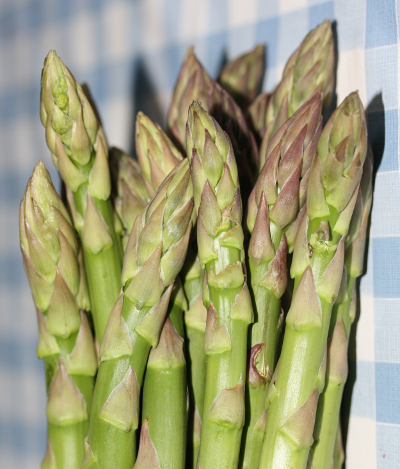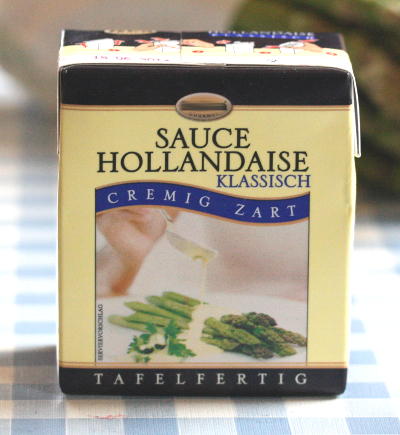Asparagus |

Tips of green asparagus

Garden asparagus is often served with a Hollandaise sauce
Etymologically, the genus name refers to either gr. spargáo what means "swell" or to the Avestan name Sparega (shoot or rod). Not only asparagus species were then called asparagus, but other edible shoots.
Comprising 160 to 300 species, the genus naturally occurs in the temperate zones of Eurasia and Africa. By the garden asparagus and some ornamental plants it has spread across all continents. The plants are hermaphrodite or dioecious, perennial herbs, subshrubs, shrubs or vines with a mostly short rhizome. The upright or twining stems are usually branched. The inconspicuous, membranous, scaly leaves are without chlorophyll are densely attached to the stem and have a spurred base, the spurs may leak into spines. From the leaf axils arise bundles of acicular phylloclades, (lateral shoots, have taken over the leaf functions and are often confused with leaves) rarely they occur solitary.
The hermaphrodite or unisexual flowers are united in axillary clusters or terminal in racemes or umbrellas, or they occur individually or in pairs. The flower stems, structured into two parts, are surrounded by a membranous bract. The 6 identically looking, whitish, greenish or yellowish petals are free or united at the base and form a bell-shaped to almost globular flower. The 6 stamens are often grown together with the petals. The superior ovary consists of 3 carpels. After insect pollination the ovary forms 1- to 6-seeded berries.
| General floral formula: |
| * [P3+3 A3+3] G(3) superior |
Historical publications
Pliny (about 23–79 AD.) reported in his Natural History often on asparagus, whereby he called the "wild" one (Asparagus acutifolius) Asparagus sylvester or Corruda and the garden asparagus simply as Asparagus. A third species would grow in the upper Germania in fields. Asparagus from the island of Nisida would be held for the best. Elsewhere Pliny rightly recognized that the asparagus possessed no leaves, he described it as prickly.
Dioskurides (1st century AD.) wrote about the asparagus, it would also called Mykantha or Myos. The cooked stalks were diuretic. A decoction of the roots would help against jaundice and toothache. The people would say, Dioscorides said, dogs would die from the decoction. Some have said, that out of chopped and buried ram's horns would grow asparagus, but he did not believe it.
Meaning of the species name
- officinalis: lat. officinalis = officinal, used for medicinal purposes
Interesting notes
Asparagus densiflorus, A. setaceus and A. falcatus are cultivated as ornamental asparagus because of its fine phylloclades in several varieties as houseplants. The inconspicuous flowers in some species smell intensively.
The berries of asparagus are toxic to humans, but not for birds. They spread the seeds that can pass intactly through the digestive tract.